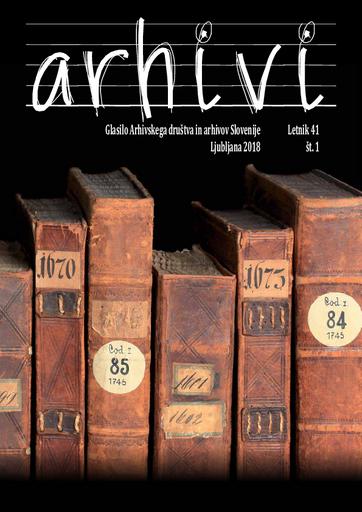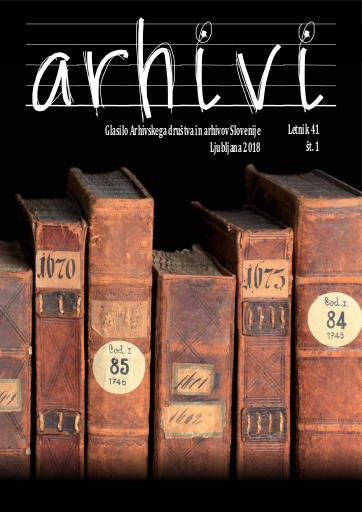/
Serijske publikacije
/
Arhivi
Zdravstvo na Celjskem med drugo svetovno vojno

Avtor(ji):Marija Počivavšek
Soavtor(ji):Gregor Jenuš (gl. in odg. ur.), Marija Grabnar (ur.), Dunja Mušič (teh. ur.), Petra Markuš (prev.), Marija Grabnar, Andreja Klasinc Škofljanec in Borut Jurca (foto.)
Leto:2018
Založnik(i):Arhivsko društvo Slovenije, Ljubljana
Vir(i):Arhivi, 2018, št. 1
Jezik(i):slovenščina
Vrst(e) gradiva:besedilo
Ključne besede:ČLANKI IN RAZPRAVE, Celje, zdravstvo, lekarna, zdravstveni dom, bolnišnica, partizansko zdravstvo, druga svetovna vojna, ARTICLES AND PAPERS, Celje, health care, pharmacy, health care centre, hospital, partisan health care, Second World War
Avtorske pravice:

To delo avtorja Marija Počivavšek je ponujeno pod Creative Commons Priznanje avtorstva-Nekomercialno-Deljenje pod enakimi pogoji 4.0 Mednarodna
Datoteke (1)

Ime:ARHIVI_2018-1.pdf
Velikost:12.28MB
Format:application/pdf
Stalna povezava:https://hdl.handle.net/11686/file25398
Opis
Before the Second World War, Celje with immediate surroundings had a
population of 18,000 and was the economic, traffic, and cultural centre of the
region. The city was well equipped also in terms of health care as it had three pharmacies as well as a health care centre, and a public hospital with maternity
hospital. The Second World War and German occupation changed the circumstances in Celje. The Germans reorganized health care service according to their
regulations, thus organizing health care service in German style. All three pharmacies, albeit mostly confiscated, persevered, while the health care centre was
reformed into a regional health agency, and persons insured under health insurance fund were treated by private doctors or in a hospital. In 1942, the head of
civil administration with jurisdiction on Celje hospital (Gaukrankenhaus Cilli)
ensured the legal uniformity of health care service in Austria and occupied Slovenian Styria. Celje hospital was thus operating in co-dependency with the Office of Public Health at the Styria Homeland Association. Germans exiled most
doctors, while appointing their own doctors and management. Although Germans had great plans to modernize and expand Celje hospital, their objectives
were only partially achieved. Several doctors and medical personnel in Celje decided to join partisans in order to help organize successful partisan health care,
care for the wounded, and relieve operative army of the severely wounded and
ill, thus allowing increased operational capability of the army. Several smaller
partisan hospitals arose in Celje area that were managed by doctors or even
medics. Hospitals that arose along the path of the XIV. Division were especially
important. The most prominent are partisan hospitals on Pohorje which were
run by dr. Ivan Kopač - Pavček, the hospital in Matkov kot, Jurklošter, on Boč,
and elsewhere.
Metapodatki (12)
- identifikatorhttps://hdl.handle.net/11686/41588
- naslov
- Zdravstvo na Celjskem med drugo svetovno vojno
- Health Care in Celje during the Second World War
- avtor
- Marija Počivavšek
- soavtor
- Gregor Jenuš (gl. in odg. ur.)
- Marija Grabnar (ur.)
- Dunja Mušič (teh. ur.)
- Petra Markuš (prev.)
- Marija Grabnar, Andreja Klasinc Škofljanec in Borut Jurca (foto.)
- predmet
- ČLANKI IN RAZPRAVE
- Celje
- zdravstvo
- lekarna
- zdravstveni dom
- bolnišnica
- partizansko zdravstvo
- druga svetovna vojna
- ARTICLES AND PAPERS
- Celje
- health care
- pharmacy
- health care centre
- hospital
- partisan health care
- Second World War
- opis
- Before the Second World War, Celje with immediate surroundings had a population of 18,000 and was the economic, traffic, and cultural centre of the region. The city was well equipped also in terms of health care as it had three pharmacies as well as a health care centre, and a public hospital with maternity hospital. The Second World War and German occupation changed the circumstances in Celje. The Germans reorganized health care service according to their regulations, thus organizing health care service in German style. All three pharmacies, albeit mostly confiscated, persevered, while the health care centre was reformed into a regional health agency, and persons insured under health insurance fund were treated by private doctors or in a hospital. In 1942, the head of civil administration with jurisdiction on Celje hospital (Gaukrankenhaus Cilli) ensured the legal uniformity of health care service in Austria and occupied Slovenian Styria. Celje hospital was thus operating in co-dependency with the Office of Public Health at the Styria Homeland Association. Germans exiled most doctors, while appointing their own doctors and management. Although Germans had great plans to modernize and expand Celje hospital, their objectives were only partially achieved. Several doctors and medical personnel in Celje decided to join partisans in order to help organize successful partisan health care, care for the wounded, and relieve operative army of the severely wounded and ill, thus allowing increased operational capability of the army. Several smaller partisan hospitals arose in Celje area that were managed by doctors or even medics. Hospitals that arose along the path of the XIV. Division were especially important. The most prominent are partisan hospitals on Pohorje which were run by dr. Ivan Kopač - Pavček, the hospital in Matkov kot, Jurklošter, on Boč, and elsewhere.
- založnik
- Arhivsko društvo Slovenije
- datum
- 2018
- 01. 01. 2018
- tip
- besedilo
- jezik
- Slovenščina
- jeDelOd
- pravice
- licenca: ccByNcSa
